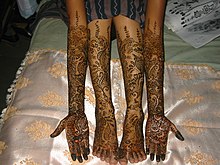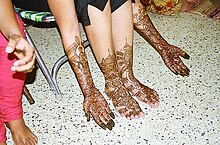Mehndi
This article may require cleanup to meet Wikipedia's quality standards. The specific problem is: Poorly written article. (February 2022) |


Mehndi () is a form of body art and temporary skin decoration from the Indian subcontinent usually drawn on hands or legs. They are decorative designs that are created on a person's body, using a paste, created from the powdered dry leaves of the henna plant (Lawsonia inermis).[1] It is a popular form of body art in South Asia including countries such as India, Bangladesh, Pakistan, Maldives, Sri Lanka, Nepal and resembles similar traditions of henna as body art found in North Africa, East Africa and the Middle East. In the West, mehndi is commonly known as henna tattoo. Henna has been used as a dye for the skin since ancient times.
There are many variations and designs. Women usually apply mehndi designs to their hands and feet, though some, including cancer patients and women with alopecia occasionally decorate their scalps.[2] The standard color of henna is brown, but other design colors such as white, red, black and gold are sometimes used.[2]
Mehndi in Indian tradition is typically applied during Hindu weddings and festivals like Karva Chauth, Vat Purnima, Diwali, Bhai Dooj, Navraatri, Durga Pooja and Teej.[3] Muslims in South Asia also apply mehndi during Muslim weddings as well as festivals such as Eid-ul-Fitr and Eid-ul-Adha.[4]
In Hindu and Sikh festivals, women often have henna applied to their hands, feet and sometimes the backs of their shoulders. Conversely, men usually have it applied on their arms, legs, back, and chest. For women, it is usually drawn on their palms, backs of their hands and on feet, where the design will be clearest due to contrast with the lighter skin on these surfaces, which naturally contains less of the pigment melanin.
Likely due to the desire for a "tattoo-black" appearance, some people add the synthetic dye p-Phenylenediamine (PPD) to henna to give it a black colour. PPD may cause moderate to severe allergic reactions when applied to skin.[5]
Etymology
The origin of "mehndi" is from the Sanskrit word "mendhika," which refers to a plant that releases a red dye.[6] According to A Dictionary of Urdu, Classical Hindi and English Mehndi also refers to "the marriage-feast on the occasion of the bride's hands and feet being stained with henna."[6]
Origins
The use of mehndi has its origins in the ancient Middle East and Indian Subcontinent where it was used in civilizations such as Babylon and Ancient Egypt. It was prevalent in fourth century in India, which is evident from cave art in the Deccan, specifically in the Ajanta Caves.[7]
Tradition


Mehndi is a ceremonial art form common in India, Pakistan, Bangladesh, and occasionally Afghanistan. It is typically applied during weddings - for Sikh, Muslim and Hindu brides. In Rajasthan, the grooms are given designs that are often as elaborate as those for brides. In Assam, apart from marriage, it is broadly used by unmarried women during Rongali bihu.
Process
Mehndi paste is usually applied to the skin using a plastic cone, a paintbrush or a stick. After about 15–20 minutes, the mud will dry and begin to crack, and during this time, a mixture of lemon juice and white sugar can be applied over the henna design to remoisten the henna mud so that the henna will stain darker. The painted area is then wrapped with tissue, plastic, or medical tape to lock in body heat, creating a more intense colour on the skin. The wrap (not a traditional method), is worn for two to six hours, or sometimes overnight, and then removed. When first removed, the henna design is pale to dark orange in colour and gradually darkens through oxidation, over the course of 24 to 72 hours. The final color is reddish brown and can last anywhere from one to three weeks depending on the quality and type of henna paste applied, as well as where it was applied on the body (thicker skin stains darker and longer than thin skin). Moisturizing with natural oils, such as olive, sesame seed, or coconut, will also help extend the lifetime of the stain. Skin exfoliation, salt water and chlorine in swimming pools can cause the henna tattoo to fade.[8]
In weddings
Example of a wedding tradition
The mehndi, a dye produced from a mehndi plant, would be delivered by the groom's relatives on a silver tray containing two burning candles.[9][10] Before the application of the henna, the guests would throw coins over the bride's head as a symbol of fertility. Then, the bride's soon to be mother-in-law would then bring out a piece of silk cloth as a gift to the bride. The bride would then walk along the unrolled piece of silk cloth in the direction of her future mother-in-law and kiss her hand.
Once this is done, fruits, nuts, and pastries would be brought out and songs would be sung in hopes of making the bride cry. This was done because it was thought that the bride's crying would bring good luck. The bride would then sit on a cushion while her mother-in-law placed a gold coin in her hand as another sign of good luck. Once the bride was given the gold coin, the henna would be applied.
The person who applied the henna was always someone who was already known to be happily married; that person would apply the henna onto the bride's palms, fingers, and toes. The henna was made from dried henna leaves, and the process of application took a long time. For this reason, it was suggested that it be applied between thirty-two and forty-eight hours before the wedding so that it may have enough time to stain the skin. In addition to the bride, most women at the mehndi ceremony also apply the henna to their hands for aesthetics.
Popular mehndi patterns

Arabic mehndi designs
This pattern is drawn on the palm. Generally it starts from one corner of the wrist and ends at finger tip on the opposite corner. Vine, lace, flowers are the main elements of this pattern.
Mandala mehndi designs
Mandala is a geometric configuration of symbols used in various spiritual traditions including Hinduism, Buddhism, Jainism and Shintoism. Various configurations of Mandala are drawn on the center of palm in this mehndi pattern.
See also
References
- ^ Gozubuyuk, G. S.; Aktas, E.; Yigit, N. (2014-12-01). "An ancient plant Lawsonia inermis (henna): Determination of in vitro antifungal activity against dermatophytes species". Journal de Mycologie Médicale. 24 (4): 313–318. doi:10.1016/j.mycmed.2014.07.002. ISSN 1156-5233. PMID 25442917.
- ^ a b "The next big thing on Eid is white mehndi, and I tried it - Style - Images". Images.dawn.com. 24 June 2017. Retrieved 2019-04-30.
- ^ Chaudhri, S. K.; Jain, N. K. (2009). "History of cosmetics". Asian Journal of Pharmaceutics (AJP). 3 (3). doi:10.22377/ajp.v3i3.260 (inactive 2022-10-22). ISSN 1998-409X.
{{cite journal}}: CS1 maint: DOI inactive as of October 2022 (link) - ^ Packard, Mary (2012-10-01). Henna Sourcebook: Over 1,000 traditional designs and modern interpretations for body decorating. Race Point Publishing. ISBN 978-1-937994-08-2.
- ^ Mukkanna, Krishna Sumanth; Stone, Natalie M; Ingram, John R (2017-01-18). "Para-phenylenediamine allergy: current perspectives on diagnosis and management". Journal of Asthma and Allergy. 10: 9–15. doi:10.2147/JAA.S90265. ISSN 1178-6965. PMC 5261844. PMID 28176912.
{{cite journal}}: CS1 maint: unflagged free DOI (link) - ^ a b "A dictionary of Urdu, classical Hindi, and English". archive.ph. 2012-07-09. Archived from the original on 2012-07-09. Retrieved 2022-05-16.
- ^ International, Aroha (2017-10-01). "History, Origin & Cultural Significance of Henna". Aroha International. Retrieved 2021-05-27.
- ^ "Get rid of fading mehendi quickly". Times of India. 17 April 2017. Retrieved 21 July 2022.
- ^ "The Beautiful and Intricate Application of Bridal Henna". The Spruce. Retrieved 19 August 2018.
- ^ "Henna Party". www.turkishculture.org. Retrieved 19 August 2018.
